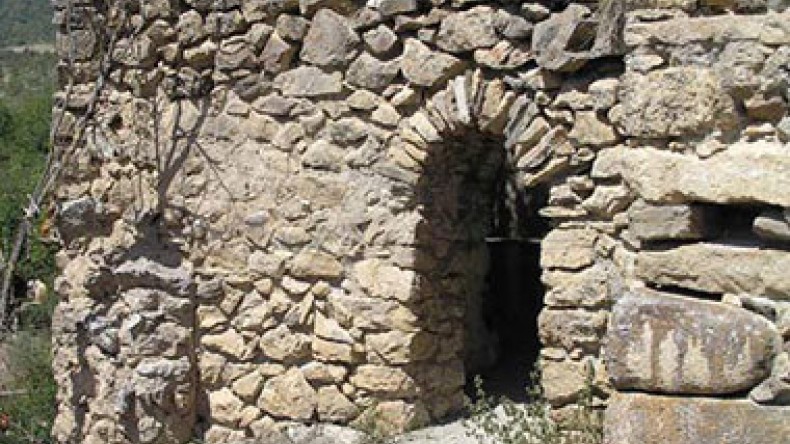
Scientific publication of Russian Empire about ancient monastery Kusanats Anapat in Artsakh
In the 19th issue for the year 1894 of the project “Collection of Materials to Describe the Terrain and Tribes in the Caucasus,” the inspector of Artsevanik school, E. Melik-Shahnazarov, published an article dedicated to the ancient monuments in the Armenian village Chenakhchi (Avetaranots) in Elisabethpol governorate, Shushi uyezd.
On a solitary cliff, by the foot of which a small river flows creating several tiny wetlands on its way, stands the Monastery Kusanats Anapat. It is situated on the very edge of the village Chenakhchi with quite a passable way connecting them.
The southern side of the cliff of the Monastery goes steeply down to the river, the eastern side is cracked into several pieces threatening to fall down, and on the west, the cliff rests on the gates of an ancient fortress, which end with the “devils’ home.”
There is no reliable data about the time, the saint or the events stimulating the foundation of the monastery. However, there is a legend about a king, who had accepted Mohammedanism and later repented and constructed the monastery to spend the rest of his life there reading the Gospel. “Since then, the village got its name Avetaranots, that is, a place where the Gospel is kept,” the author explains.
According to the author, the monastery served as a shelter for nuns and sisters who since ancient times spent their time in peaceful readings of the Gospel. However, Agha Mohammad Khan’s invasion in 1797 put an end to that quiet life. According to a legend, when the Persian sarbazes (soldiers) broke into the village, the nuns managed to hide in the nearby forest. Still, one of them had left something she needed in the monastery and went back for it. When she came out of the monastery, a Persian soldier’s sword flashed above her head. She was able to run to the edge of the cliff, ask for the Holy Trinity and St. Mary’s help and threw herself down the cliff. “An invisible power helped her land harmless and hide in the forest,” the author writes.
Among the numerous legends about the monastery Kusanats Anapat, there is the story of the True Cross embedded in silver and taken away with other precious utensils during the invasion of the Persian troops. “But six months later, the cross transformed into a falcon and flew away from the captivity. It flew back to its native village and transformed to its initial form again,” the legend says. As another legend has it, a deer appeared here every year on the Resurrection Sunday, and willfully, as a victim sent by the Heaven, put its neck under knife.
As for the architectural peculiarities of the monastery, the author writes that it is constructed of local ashlar stones and has basilica form. It has a simple roof with two pitches overgrown with moss, grass and dog-rose bushes. A rectangular piece of stone carrying image of a cross is placed on the eastern corner of the roof.
“The ground plan has the shape of a cross. The monastery has one narthex on its south-western side, where some of its pious nuns and meliks rest. Besides the narthex, there is a separate annex where the sisters lived. The windows, one on the southern and three on the eastern wall, are narrow and without decorations meagerly letting in the light,” the author describes.
There are two hiding-places on both sides of the stone altar. The icon of the Sorrowful Mother is placed on it. Two ashlar columns support lancet arches. Three arches between the columns are laid of smooth stones and are covered with numerous tiny inscriptions. The height of the arches, the dusk under them and the oldness make those inscriptions difficult to read. Big stones with beautiful ornaments are laid on the external walls.
“The monastery Kusanats Anapat has never been, nor will it ever be, a parish church. Sometimes the local priests hold prayer services there to spare it from God’s punishments – drought, hail, illnesses, field mice, grasshoppers and the like,” Melik Shahnazarov writes. He also writes that there was a small flat space in front of the monastery, which the youth of the village, both male and female, used for entertainments on holidays.
The “Collection of Materials to Describe the Terrain and Tribes in the Caucasus” is a large-scale publication of narrative sources carried out by the management of the Caucasus Educational Okrug in 1881-1908. It includes researches and description of the history, life, and ethnographic characteristics of the peoples inhabiting the Caucasus region of the Russian Empire.
Related:
19th century scientific edition of Russian Empire compiled historical data about ancient Erivan
Scientific edition of Russian Empire: Nakhijevan was prominent Armenian city founded in C16 BC
Scientific publication of Russian Empire about destruction of Christian monuments in Barda by Tatars
Scientific edition of Russian Empire: For 40 centuries no nation justified Armenians’ trust
Newsfeed
Videos






























